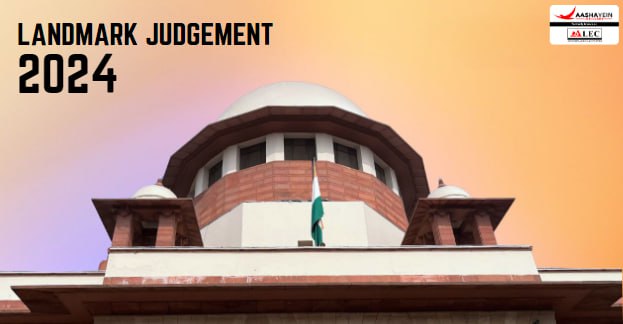In 2024, the Supreme Court of India delivered several landmark rulings that showcased its commitment to legal reforms. Notable decisions included striking down the electoral bonds scheme or the landmark judgement on sub-classification. In this year only, Justice Sanjiv Khanna was appointed as Chief Justice of India which marked a significant shift, with a focus on reducing case backlogs and enhancing judicial efficiency. This blog highlights some of the most important judgments delivered by the Supreme Court in 2024.
- “Association of Democratic Reforms v Union of India”
In preparation for the 2024 Lok Sabha Elections, a five-judge bench of the Supreme Court struck down the 2018 Electoral Bond (EB) Scheme. The scheme allowed corporations, individuals, and organizations to donate anonymously to political parties. On 15 February 2024, the Court unanimously ruled that voters have a fundamental right to know the sources of political party funding. The Court found the scheme inadequate and not aligned with the Union Government's justification of protecting donors from retaliation by rival parties. To uphold free and fair elections, the Court immediately halted the sale of electoral bonds and directed the Election Commission and the State Bank of India to publicly disclose all data collected on EB transactions.
Following the disclosure, citizens, journalists, and researchers analyzed the data, identifying potential links between donations, government contracts, and the suspension of criminal investigations. However, in August 2024, the Court declined to establish a Special Investigation Team (SIT) to investigate the alleged quid pro quo, stating that such allegations were based on mere speculation.
You can also read the latest judgment by visiting [Latest Judgment].
For more information, visit [Aashayein Enquiry Section]
- “Bilkis Yakub Rasool v Union of India”
In a landmark 2024 judgment, the Supreme Court quashed the Gujarat government’s order releasing 11 convicts in the Bilkis Bano case. The convicts, sentenced to life for gang rape and murder during the 2002 Gujarat riots, were tried in Mumbai, making Maharashtra the competent authority for remission decisions. The Court noted that the Gujarat government knowingly entertained an improper application and acted “in tandem” with the convicts. Justice B.V. Nagarathna stressed that remission requires respect for the rule of law and affirmed that courts can quash administrative remission orders if found improper.
- “State of Punjab v Davinder Singh”
In a significant ruling on affirmative action, a seven-judge bench of the Supreme Court upheld the power of states to create sub-classifications within the Scheduled Caste (SC) and Scheduled Tribe (ST) categories. The bench, led by Chief Justice D.Y. Chandrachud, overturned the 2004 decision in E.V. Chinnaiah v. Union of India with a 6:1 majority.
The Court reasoned that sub-classification promotes "substantive equality" by addressing varying levels of discrimination faced by different communities within the SC/ST lists. However, it emphasized that any law introducing sub-classification must be based on empirical evidence and remain subject to judicial review.
Following the judgment, several states have taken steps to implement sub-classification. Haryana became the first, to approve a 10% ‘sub-quota’ for deprived SCs in government jobs based on the Haryana Scheduled Caste Commission Report. Similarly, Telangana announced plans to finalize sub-classification measures, with Chief Minister Revanth Reddy confirming positive steps for the Madiga community, which has been a key proponent of this reform.
- “Property Owners Association v State of Maharashtra”
The Supreme Court, by an 8:1 majority, ruled that not all privately owned property can be considered a "material resource of the community" under Article 39(b) of the Constitution, which is a Directive Principle of State Policy.
The Court also addressed whether Article 31C, as interpreted in Kesavananda Bharati v. State of Kerala, continued to remain part of the Constitution after the ruling in Minerva Mills v. Union of India. The judges unanimously held that Article 31C still exists, clarifying that striking down the amendment expanding its scope did not remove the Article entirely from the Constitution. Justice Dhulia dissented, opining that all private property qualifies as a material resource of the community.
- “Mineral Area Development Authority v Steel Authority of India”
The Supreme Court, in an 8:1 majority decision, held that “royalty” under the Mines and Minerals (Development and Regulation) Act, 1957, is not a tax. It also ruled that states have the authority to impose taxes on mines and minerals under Entries 49 and 50 of the State List. This judgment overruled the earlier decision in India Cements v. State of Tamil Nadu (1989), which had classified royalty as a tax.
The majority opinion stated that royalty is a payment made by miners to landowners and lacks the essential characteristics of a tax. However, Justice B.V. Nagarathna dissented, arguing that royalty resembles a tax due to its compulsory nature, and cautioned that the ruling might create an unequal tax system favoring mineral-rich states. Subsequently, the Court clarified that the judgment would apply retrospectively, directing mining companies to clear outstanding dues in instalments over 12 years, starting from 2026

